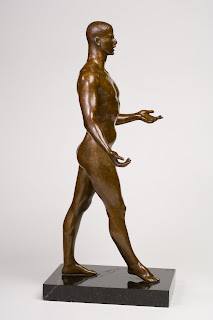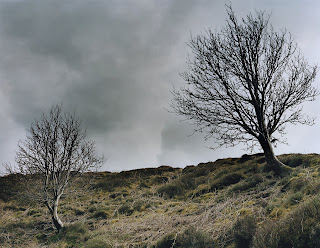How many of us yearn to leave the workaday world behind and pursue our passions?
OK, now how many of us actually do?
One who did is Emily Tabin, a former lawyer-turned-alto-saxophonist and founding executive director of the Westchester Jazz Orchestra. I interviewed Emily for the Aug. 30th edition of the Westchester County Business Journal and was impressed not only by her commitment to jazz but her ability to take risks -- not something everyone can do.
Anyway, Emily wants to get the word out that WJO is back for a new season at the Irvington Town Hall Theater beginning Sept. 25 with a tribute to sax stylist Michael Brecker, featuring bro Randy, a trumpeter. There are also salutes to Louis Armstrong, Miles Davis and Dizzy Gillespie (Dec. 4), Herbie Hancock (Jan 29) and Thelonious Monk and Gerry Mulligan (April 2).
Tickets: westjazzorch.org and after Labor Day, 914-591-6602. Information: 914-861-9100.
Georgette Gouveia is a reporter for Westfair Communications Inc., which publishes the Westchester County Business Journal, the Fairfield County Business Journal and HV Biz. Read her stories at westfairinc.com.
Wednesday, August 25, 2010
Friday, August 13, 2010
American colossus
 Kudos, too, to the Bruce Museum in Greenwich, which has just
Kudos, too, to the Bruce Museum in Greenwich, which has justacquired one of only two casts of Gaston Lachaise's "Man Walking (Portrait of Lincoln Kirstein)".
The bronze sculpture is on view in the rotunda of the museum.
Lachaise, a Franco-American sculptor of the early-20th century, was better known for his hourglass female nudes, inspired apparently by Mme. Lachaise. But he also created heroic men to go along with his voluptuous women as seen at Kykuit, the historic Rockefeller family estate in Pocantico Hills.
Certainly, this image of Kirstein -- the arts impressario who founded the New York City Ballet with George Balanchine -- is no exception.
For more on the Bruce, log on to brucemuseum.org or call (203) 869-0376.
Image courtesy of the Bruce Museum.
Georgette Gouveia is a reporter for Westfair Communications, which publishes the Westchester County and Fairfield County Business Journals and HV Biz.
Scribes' corner
Kudos to Sarah Bracey White, Greenburgh cultural goddess, South Salem writer and curator Pamela Hart and Hastings-on-Hudson fiction writer Christine Lehner, the first fellows of the new Purchase College Writers Center, opening this fall.
The three will be given small stipends, offices in the college's library and access to its data base. All of you writers (and artists of any stripe) out there know how important it is to have "a room of one's own," as Virginia Woolf put it, in which to create. So we can enjoy their opportunity vicariously.
I've known Sarah for years in her other guise, as tireless exhibit and poetry-series organizer for the town of Greenburgh. Christine I interviewed when she published her wry story collection "What to Wear to Meet the Pope."
Pamela Hart is a new name to me. But she has a foot in the world of the visual arts as well as the literary world, and I often find that writers make the best curators, as in the case of the Jewish Museum's marvelous "Kafka" show of a few seasons back and the Neuberger Museum of Art's "British Subjects" exhibit by Purchase College humanities head Louise Yelin, who'll direct the new Writers Center.
Sarah thinks it's a writer's storytelling ability that makes for curatorial expertise. I think, too, writers paint and sculpt -- just with words -- so they bring a different perspective to the visual.
You can read my story on Sarah in Monday's edition of the Westchester County Business Journal.
Georgette Gouveia is a reporter for Westfair Communications, which publishes the Westchester County and Fairfield County business journals and HV Biz.
The three will be given small stipends, offices in the college's library and access to its data base. All of you writers (and artists of any stripe) out there know how important it is to have "a room of one's own," as Virginia Woolf put it, in which to create. So we can enjoy their opportunity vicariously.
I've known Sarah for years in her other guise, as tireless exhibit and poetry-series organizer for the town of Greenburgh. Christine I interviewed when she published her wry story collection "What to Wear to Meet the Pope."
Pamela Hart is a new name to me. But she has a foot in the world of the visual arts as well as the literary world, and I often find that writers make the best curators, as in the case of the Jewish Museum's marvelous "Kafka" show of a few seasons back and the Neuberger Museum of Art's "British Subjects" exhibit by Purchase College humanities head Louise Yelin, who'll direct the new Writers Center.
Sarah thinks it's a writer's storytelling ability that makes for curatorial expertise. I think, too, writers paint and sculpt -- just with words -- so they bring a different perspective to the visual.
You can read my story on Sarah in Monday's edition of the Westchester County Business Journal.
Georgette Gouveia is a reporter for Westfair Communications, which publishes the Westchester County and Fairfield County business journals and HV Biz.
Wednesday, August 4, 2010
Haunting
 Have you ever encountered an artist who seemed like an instant soul-mate?
Have you ever encountered an artist who seemed like an instant soul-mate?That's how I feel about British photographer Sam Taylor-Wood. Her "Crying Men" series -- images of male movie stars like Robert Downey Jr. and Jude Law weeping -- was an obsession until I found the rare portfolio in the Museum of Fine Arts, Boston bookstore. It was like acquiring the Holy Grail.
Now "Ghosts" -- her 2008 series inspired by one of my favorite books, Emily Bronte's "Wuthering Heights" -- is slated to come to the Brooklyn Museum Oct. 30-Aug. 14. (The show will be held in the Herstory Gallery of the Elizabeth A. Sackler Center for Feminist Art, which contains Judy Chicago's installation "The Dinner Party," in which Emily and sister Charlotte are honored.)
Discovering "Ghosts," I feel like the eccentric sister of the Hugh Grant character in "Notting Hill," who gushes to Julia Roberts' put-upon movie star, "I just know we could be great friends."
What is it about "Heights" that haunts? I think it is in part that it's a wholly original work of art -- as unfashionable as that idea is in our age of "appropriation" (otherwise known as plagiarism).
Think about it: As great as Charlotte's "Jane Eyre" is, there are lots of men like her Rochester, who make bad marriages and pay and pay for it. And lots of women like Jane, mousy good girls who secretly yearn to be loved by their bad boys for their sedate but sterling selves.
But there is no one -- no one -- like Emily's Cathy and Heathcliff. And indeed if there were, you'd run screaming in the other direction. The brutality with which Emily Bronte portrays their all-consuming relationship -- which crushes everything and everyone in its brambled path -- is like nothing else in literature. (The only film version ever to capture this is the idiosyncratic one starring Ralph Fiennes and Juliette Binoche.)
In "Sexual Personae," outre cultural critic Camille Paglia theorizes that Heathcliff represents Emily mixed with Byron, a truly androgynous persona. Others have wondered if Emily was in love with God. "Heath cliff" -- a name that signifies the earth -- represents her union with God in death.

Me? I've always wondered if Heathcliff were the singularly self-possessed Emily -- writing her novel, stories and poems in obscurity while tending to the family at Haworth Parsonage -- and the betraying Cathy were the more conventional Charlotte, torn between literary (worldly) success and the sisters' closed society on the Yorkshire moors that Taylor-Wood has captured with such spare resonance.
That a book can conjure so many interpretations demonstrates just how haunting it remains.
Images of Sam Taylor-Wood's "Ghosts VI" (above) and "Ghosts II" (right) courtesy of the Brooklyn Museum. For more on the show, log on to brooklynmuseum.org or call 718-638-5000.
Georgette Gouveia is a reporter for Westfair Communications Inc., which publishes the Westchester County Business Journal, the Fairfield County Business Journal and HV Biz. You can read her stories at westfaironline.com.
Beating the "Dutch"
 As I reported in an Aug. 2 piece for the Westchester County Business Journal, the Hudson Valley Center For Contemporary Art in Peekskill is planning a fall show that should do for Eastern Europe what "Double Dutch" did for The Netherlands.
As I reported in an Aug. 2 piece for the Westchester County Business Journal, the Hudson Valley Center For Contemporary Art in Peekskill is planning a fall show that should do for Eastern Europe what "Double Dutch" did for The Netherlands."After the Fall" (Sept. 19-July 24) considers 18 emerging artists from East and Central Europe,
people like Romanian painter Leonardo Silaghi -- represented here by his "Untitled" -- who were born under Communism but came of age post-Gorby.
To what extent did Communism -- a monstrously idealistic philosophy that was doomed to failure -- shape these artists? In Silaghi's case, his "Untitled" seems to have captured the gray, workaday image of the proletariat. Remember the marvelous commercial that satirized Commie fashion with the same potato-sack outfit for swimwear, day wear and evening wear (the last accessorized by an industrial flashlight)? Silaghi's painting has something of that pointed drabness.
In any event, it's always intriguing to consider the effect that a time and a place have on an artist. It should be another provocative HVCCA show.
The notion of "After the Fall" reminds me of a concert I covered years ago when Philharmonia Virtuosi, led by the late, lamented Richard Kapp, was one of the house "bands" at Purchase College (then SUNY Purchase). Among the concerts' treats were Kapp's witty, erudite asides to the audience about music and life -- like the cartoon he saw riffing on The Mostly Mozart Festival that contained three banners -- "Mostly Mozart, Basically Bach and Practically All the Telemann You Can Stand."
Anyway, this was the 1980s, the end of the Cold War, and Kapp once remarked that there was no need to defeat the Soviet Union militarily.
"We'll conquer them with our culture," he said.
Today, everyone in Russia looks like they stepped out of an episode of "Law & Order."
How prescient that remark turned out to be.
Photo courtesy of HVCCA. For more on the show, log on to hvcca.org or call 914-788-0100.
Georgette Gouveia is a reporter for Westfair Communications Inc., which publishes the Westchester County Business Journal, the Fairfield County Business Journal and HV Biz. You can read her stories at westfaironline.com.
Subscribe to:
Posts (Atom)




